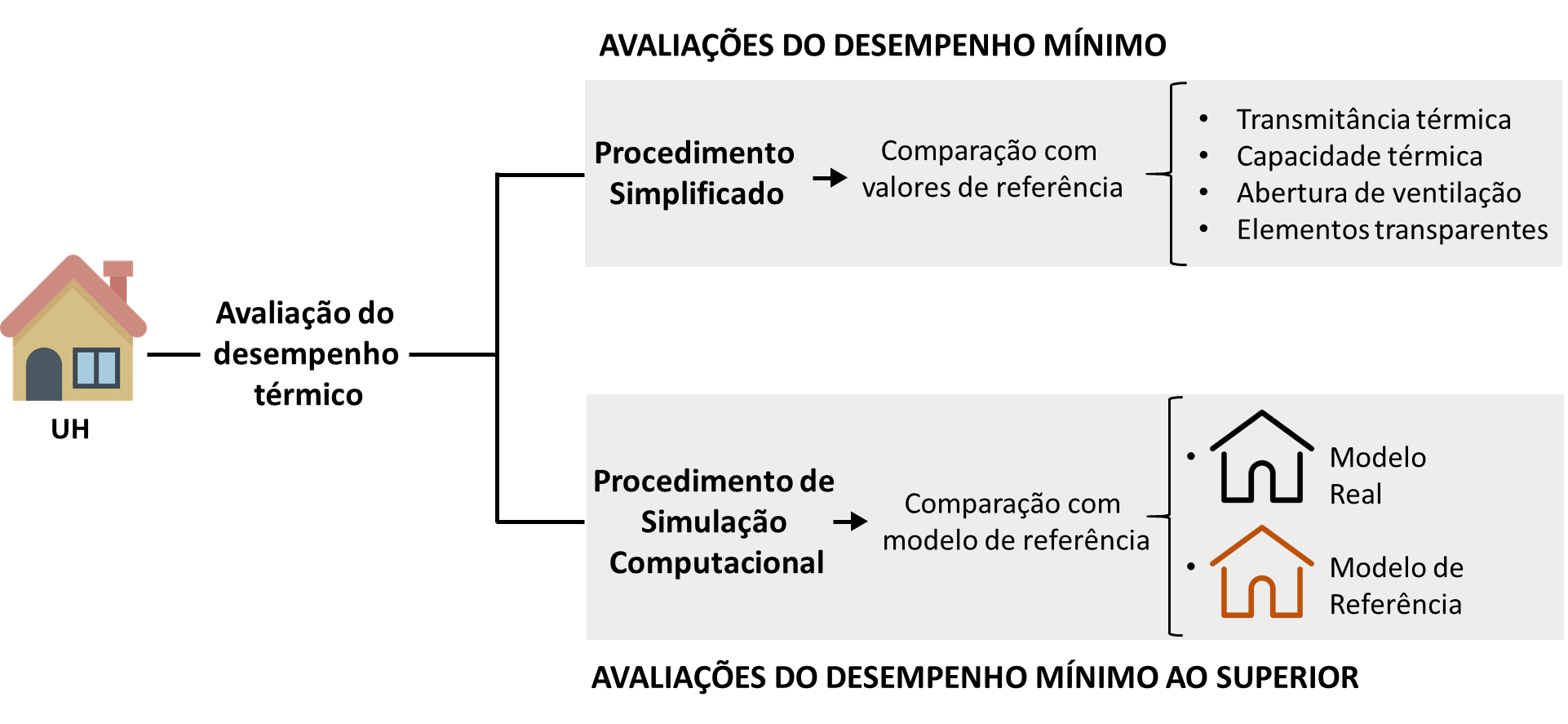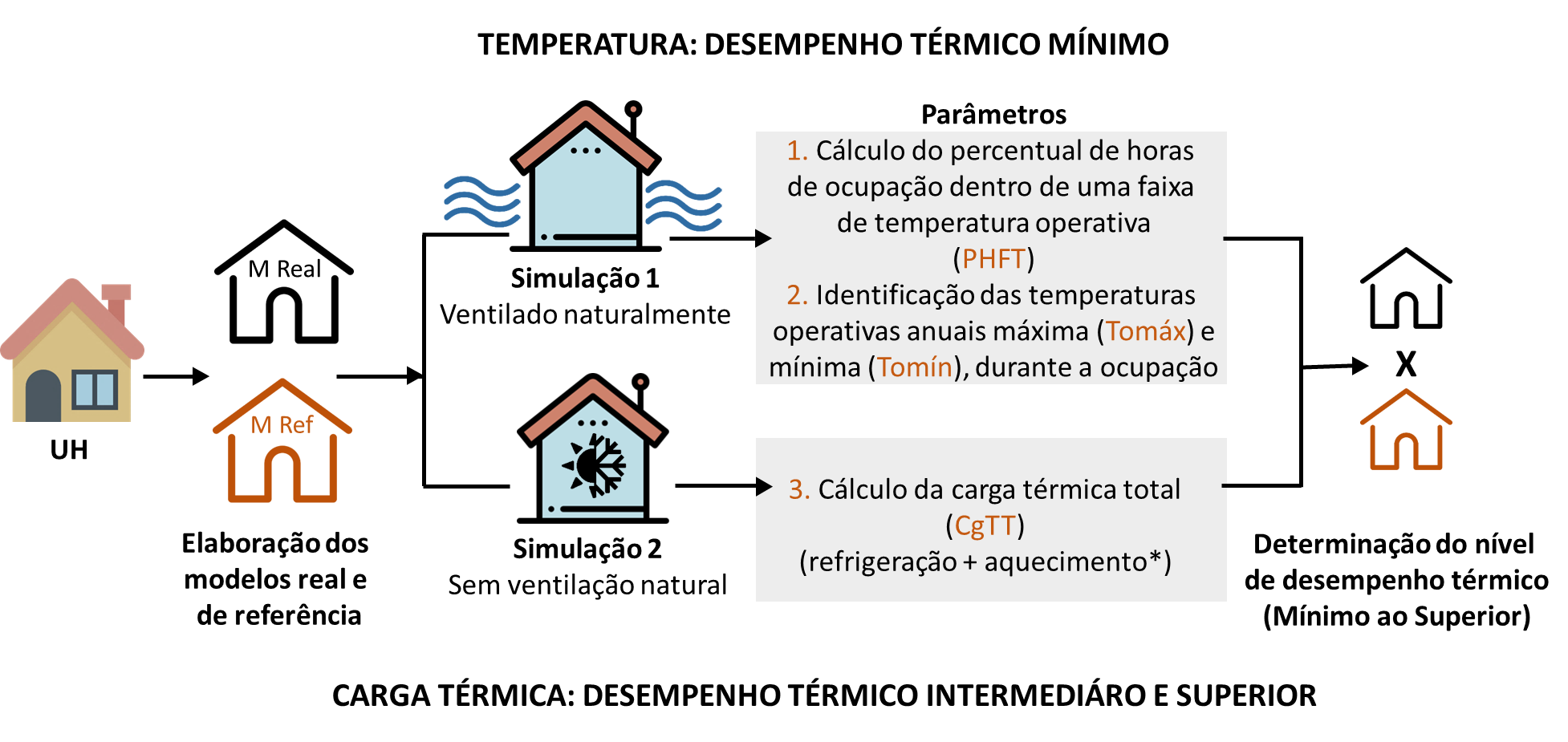The Brazilian norm for the performance of residential buildings, ABNT NBR 15575 (ABNT, 2013), came into force in 2013, with the aim of establishing user requirements for housing environments. Performance is considered by the norm as the “behavior in use of a building and its systems”. Therefore, among the habitability requirements, thermal performance is established, which aims to guarantee the user adequate thermal conditions for carrying out their activities in the home.
Considering the limitations identified in the 2013 method (SORGATO et al, 2012), in 2018 LabEEE began preparing a proposal to review the thermal performance analysis of NBR 15575. After a period of development and consolidation of the new method, in 2020, the text proposed for the review was sent to the ABNT Study Committee and, after discussions, the standard amendment entered into a national consultation between November 17th and December 16th, 2020. Publication is scheduled for early 2021.
According to the proposed method, thermal performance assessment can be carried out through two procedures, simplified (Part 4 – Requirements for internal and external sealing systems - SVVIE and Part 5 – Requirements for systems coverage) or computer simulation (Part 1 – General Requirements), as illustrated in the figure below.

The simplified procedure evaluates the minimum thermal performance of the housing unit (HU). In the new text, the main innovation in this procedure was the implementation of the “Transparent elements” criterion in Part 4 of the regulations. This criterion limits the surface area of transparent elements in extended stay environments (APP), living rooms and bedrooms, in proportion to the floor area. The proportion allowed for transparent elements also considers the existence of horizontal shading, the solar factor of the glass or the frame label (according to ABNT NBR 10821). In the 2013 regulatory text there was no limit to the glass area in APPs, allowing the construction of fully glazed HUs.
Another point of innovation in the amendment is the recommendation that the degradation of absorptance to solar radiation be considered, indicating measurement procedures or values obtained in field studies. In the proposed normative text, the consideration of degradation is informative in nature, which is already considered an advance, given that previously the possibility of the thermal properties of surfaces changing over time was not mentioned.
The computational simulation procedure represents the most comprehensive and representative way of analyzing thermal performance available in the method proposed for NBR 15575, allowing evaluations to obtain all performance levels (minimum, intermediate and superior). Some of the main updates proposed for the computer simulation procedure are:
- Adoption of annual simulations, as opposed to considering typical summer and winter days;
- Consideration of the building in the use and operation phase, as the internal thermal loads are modeled (people, lighting and equipment);
- Assessment of the building under two conditions of use: with natural ventilation and without natural ventilation. Natural ventilation strategies are considered, associated with the quantification of the thermal load to be removed when ventilation is insufficient to obtain adequate thermal conditions in the environments;
- Modeling of operable windows, with air exchange obtained from the wind speed and direction provided by the climate file, instead of a fixed air exchange rate without opening the windows;
- Consideration of the calculation of thermal load, in order to evaluate the thermal performance of the building in relation to the use of air conditioning systems, as this equipment is increasingly present in Brazilian homes (EPE, 2020);
- Analysis considering the comparison between a model of the designed building and a reference model (same building with reference characteristics);
- Establishment of new indicators for evaluating thermal performance: Percentage of occupancy hours within an operating temperature range (PHFT); maximum and minimum annual operating temperature of the UH (Tomáx and Tomín); and total thermal load (CgTT).
The figure below illustrates which thermal performance indicators and simulation models are necessary for the assessment of minimum, intermediate and higher levels.

Below we provide some documents that can support the application and understanding of the proposed amendment to the thermal performance chapters of NBR 15575. Among the documents are the amendments to Parts 1, 4 and 5 of NBR 15575 and the Standard Base for Climate Files to execute computer simulations.
- Amendment NBR 15575-1
- Amendment NBR 15575-4
- Amendment NBR 15575-5
- Standard base of weather files
- Example simulation file (single-family residence – reference model)
- Indicator calculation spreadsheet
- Article published at XVIII ENTAC 2020: “Proposal of a Method for Assessing the Thermal Performance of Residences: NBR 15575”
- Article published at XVIII ENTAC 2020: “Proposal for the Scales of Residential Thermal Performance Levels: NBR 15575”
- Manual for computer simulation of buildings using the Ground Domain object in the EnergyPlus program – Version 9.0.1
- Manual for computer simulation of naturally ventilated buildings in the EnergyPlus program – Version 9.0.1
- Training videos in the thermal performance section of NBR 15575-1:2021, computer simulation procedure
SORGATO, M.J.; MARINOSKI, D.L; MELO, A.P.; LAMBERTS, R. Nota técnica referente à avaliação para a norma de desempenho NBR 15575 em consulta pública. 2012.
ABNT ASSOCIAÇÃO BRASILEIRA DE NORMAS TÉCNICAS. NBR 15575: Edificações habitacionais - Desempenho. Rio de Janeiro, 2013.
ABNT ASSOCIAÇÃO BRASILEIRA DE NORMAS TÉCNICAS. NBR 10821: Esquadrias para edificações, Parte 4: Esquadrias externas – Requisitos adicionais de desempenho. Rio de Janeiro, 2017.
EPE. EMPRESA DE PESQUISA ENERGÉTICA. NOTA TÉCNICA: AÇÕES PARA PROMOÇÃO DA EFICIÊNCIA ENERGÉTICA NAS EDIFICAÇÕES BRASILEIRAS: NO CAMINHO DA TRANSIÇÃO ENERGÉTICA. Brasília, 2020. Disponível em: <https://www.epe.gov.br/sites-pt/publicacoes-dados-abertos/publicacoes/D…;. Acesso em: 04 dez. 2020.
- Roberto Lamberts - Curriculum Lattes
- Ana Paula Melo - Curriculum Lattes
- Deivis Luis Marinoski - Curriculum Lattes
- Amanda Fraga Krelling - Curriculum Lattes
- Cristiano André Teixeira - Curriculum Lattes
- Letícia Gabriela Eli - Curriculum Lattes
- Lorrany da Silva Mendes - Curriculum Lattes
- Marcelo Salles Olinger - Curriculum Lattes
- Rayner Maurício e Silva Machado - Curriculum Lattes
- Rodolfo Veiga - Curriculum Lattes
- Tiago de Castro Quevedo - Curriculum Lattes